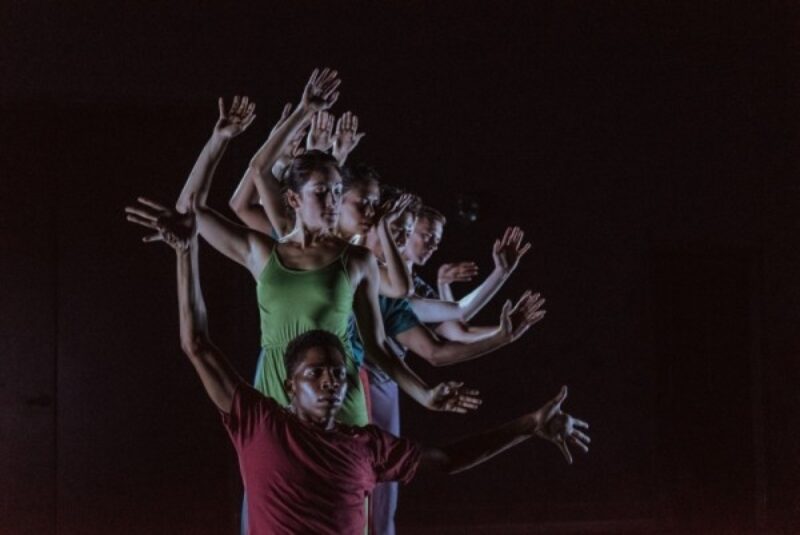What Happens When You Give Dancers A Say?

I used to be a dancer. When I danced, however, I never felt closely connected with what I was asked to perform. Sure, The Nutcracker and Sleeping Beauty were classics, but their stories didn’t represent my identity. I didn’t feel that my dancing reflected who I was.
At Whim W’Him’s Choreographic Shindig IV, however, the company could choose pieces and choreographers that reflected them. For the Choreographic Shindig IV, the dancers chose three choreographers—Alice Klock, Brendan Duggan, and Omar Román de Jesús. These artists, using the dancers’ input, created three 20-minute pieces: "Before After," "Stephanie Knows Some Great People," and "Welcome to Barrio Ataxia."
Klock’s piece, "Before After," dealt with the death of one world and the birth of the next. It began with the end: a spotlight illuminated a soloist clad in grey, slowly rubbing his hands together. He then moved about the space, clearly suffering. When he was spent, he collapsed to the ground. His death sharply contrasted with what came next. Two dancers, wearing green, created life through fluid extensions and expansive gestures, their movements reminiscent of youthful deer running across a field.
At the Q & A panel after the show, a dancer stated that “Alice came in [on] the first day and asked each of us what we found magical in the world… and then, from there, she structured a character for us.” In this creation story, each dancer embodied their answer to Alice’s question. Some words, such as “time,” were abstract, whereas others, like “death,” were specific, clearly imaginable concepts. This difference was echoed in the choreography. Certain sequences utilized animalistic gestures that occur in everyday life; dancers would bob their heads like pigeons, for example. Most of the time, the gestures used were expressive and undefinable—like when the company would jump in unison while slapping their hands together. Similarly, in the natural world, there are many concepts and ideas, (love comes to mind), that we cannot fully express through words, yet are still all-encompassing. Nature and world-creation are both beautiful and indescribable, and "Before After," through both birth and death, spoke to how awe-inspiring the two are.

Whim W'Him dancers in "Stephanie Knows Some Great People" choreographed by Brendan Duggan. Photo by Stefano Altamura.
Duggan’s piece, "Stephanie Knows Some Great People," explored the differences between public and private perception. The piece was set around a cocktail party, with several caricatured characters gossiping around the room. Each seemed to have a date, except for one—Andrew—who, with his monochromatic clothing and awkward demeanor, was clearly out of place. Throughout the course of the party, Andrew became increasingly isolated from the rest of the group, until he broke up the party by breaking down. Suddenly, the characters’ bubbly exteriors gave way to something much more sinister. Andrew and the party’s overly friendly host sat on the floor, facing one another, and performed a duet while the rest of the company stood watching. The two were mirror images, each repeating lines from the party while contorting themselves into increasingly unnatural positions.
During the course of the piece, each character had their own dancer-created solo showcasing their private selves. These over-the-top characters were actually extensions of the dancer’s personalities, and had been specifically chosen for each company member. Because private personas were ones that the dancers would have preferred to keep hidden, the performance of this piece allowed the audience to see that there is nothing wrong with negative personality traits, and that it’s important to embrace both your public and private self.
Finally, the third piece, "Welcome to Barrio Ataxia," focused on the difference between mania and depression. As stated in the Q & A, the inspiration for the piece was a friend of de Jesús’ with bipolar disorder, and the sharp differences between the up-tempo and sedate portions of the song echoed the disorder’s mood swings. During a faster song, dancers, limbs shaking, moved around the space, punctuating the uplifting music with sharp pops of the head and body. Twice, they formed a circle surrounding a girl in grey, and pushed her head down while lip-syncing, creating the sense that something was not quite right—someone was being held against their will, just like the disorder holds people in its grip.

Whim W'Him dancers in "Welcome to Barrio Ataxia" choreographed by Omar Román de Jesús. Photo by Stefano Altamura.
As the music changed to a slower, sadder song, the girl was helped by a friend, and the two danced together. Exhausted, the girl placed her head on his shoulder, and, as he supported her in her time of need, they experienced a moment of connection. The piece delved into the notion of how hard it is to be a caretaker—a vital, painful task. Caretaking can be exhausting at times, but it is necessary.
Although these pieces were about wildly different topics, they all explored two ends of a spectrum. Because of the choreographer’s use of the dancers’ input during the creation process, the company was clearly invested in every piece. All three pieces were well choreographed and beautiful to watch, but also beautiful because of the knowledge that the dancers picked them. Honestly, the dancing and choreography could have been terrible, and I would still have been intrigued, simply because of the energy and passion shown by the company.
I quit dance, in part, because I felt I was pandering to the audience; the shows I performed in didn’t have a message I wanted to share. But the Choreographic Shindig IV helped me see that there are shows that can appeal to both the dancer and the audience. Shows that, rather than force their viewers to sit, bored, in a theater for two hours, can inspire.
The TeenTix Press Corps promotes critical thinking, communication, and information literacy through criticism and journalism practice for teens. For more information about the Press Corps program see HERE.


